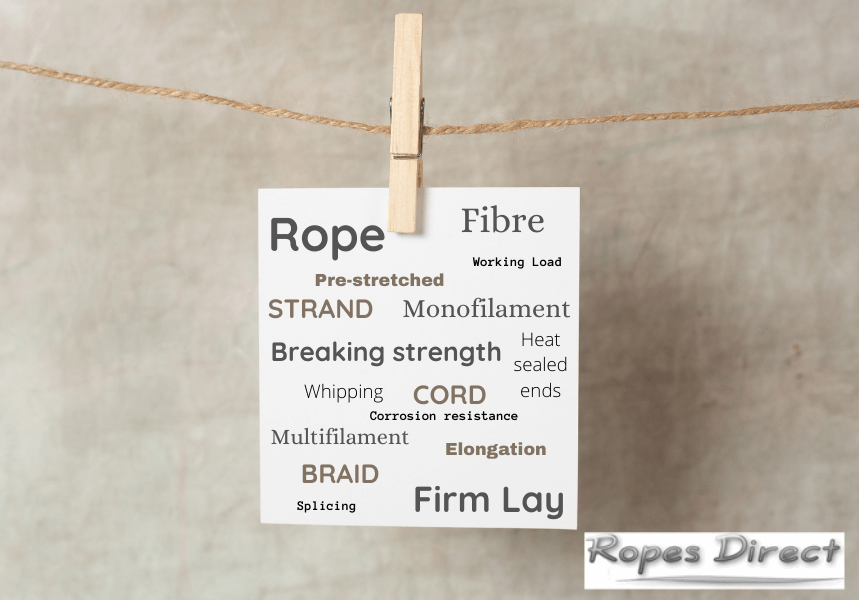Buying rope. How hard can it be?
Well, here at RopesDirect, we try to make the process as easy and hassle-free as possible. Our website is full of useful information to help guide your decision. And if you have a question or would like a little tailored advice on your purchase, we’re always at the other end of the phone.
After all, our goal is to ensure that you as our customer are happy with the service we provide. And we understand that, for first-time buyers, rope terminology can be a little confusing! So to help, we’ve created a quick guide to some of the main words and phrases used within the rope industry.
Be sure to take a look before you start shopping. And if you’re still struggling, you’re welcome to give us a call and pick our brains whenever you like.
Key rope terminology to look out for
Abrasion resistance
‘Abrasion resistance’ refers to the ability of a rope to resist surface wear and tear – such as that caused by friction, when the soft fibres come into contact with a rougher or harder surface.
Braided rope
This is a rope that has been created by weaving strands into a braid. There are three types of braided rope: single, double, and kernmantle. More information on the differences between these can be found on our sister site, ParacordsDirect, in the blog ‘Understanding braided rope constructions’.
Breaking strength
Also known as the tensile strength. This is the weight or force required to break a brand-new rope, determined by the manufacturers through testing under controlled conditions.
Cord
A cord is made from six strands of fibre or more, that have been braided together to create a tube.
Corrosion resistance
This refers to a rope’s ability to resist corrosion or physical degradation, despite being exposed to, for example, water, chemicals, heat, UV light and other substances.
Elongation
Elongation is a term most commonly used for shock (bungee) cords. It is the maximum level of stretchiness that the cord can achieve and is expressed as a percentage of the cord’s unstretched length. For example, a 10m bungee cord with a 100% elongation rating, would stretch to 20m during use. Whereas a 10m cord, with a 50% elongation, would only stretch to 15m.
Fibre
A fibre is a thread or filament that can be used to create rope. They can either be natural, taken from a plant or vegetable, or synthetic and created from an artificial material (such as plastic).
Firm Lay
The term ‘lay’ is used to describe the nature of a rope’s construction. If a rope has a ‘firm lay’, it tends to be much stiffer – making it suitable for applications where control is required (e.g. pet leads).

Heat-sealed
This is a popular type of rope end finish; and, here at RopesDirect, it is used as standard for all synthetic ropes. Each end is cut and sealed with a heat knife, so they won’t fray or unravel.
Monofilament
Monofilament is the word used to describe synthetic thread that is composed of just one filament, in one continuous length. This thread is an extruded polymer.
Multifilament
By contrast, multifilament refers to a synthetic thread that is composed of many fine, continuous filaments. These threads are produced by extruding and spinning a polymer.
Pre-stretched
Just as you might expect, a pre-stretched rope is one that has been intentionally stretched by the manufacturer – to ensure that it has a ‘low stretch’ rating when it is sold.
Splicing
Another type of rope end finish. Splicing is a technique that terminates the rope, without using a knot, and prevents the fibres from fraying. The rope is looped back on itself and interwoven to create either a soft eyelet (i.e. soft splice) or hard eyelet (i.e. hard split) with a metal thimble. You can also use a splice to join two lengths of the same rope together.
Strand
A strand is a collection of fibres that have been twisted together. Subsequently, these strands are twisted or braided to create the final rope (e.g. a 3-strand rope is created by twisting 3 strands).
Whipping
Whipping is a traditional rope end finish, used for both natural and synthetic ropes. Flax twine is spun (or whipped) around each end of the rope to prevent unravelling and create a tidy finish.
Working Load
This is the maximum weight that a rope can take, whilst also ensuring safety. It is calculated by considering the breaking strength of the rope, whilst factoring in a range of other variables, including the material from which the rope is made, its construction, age and overall condition.

